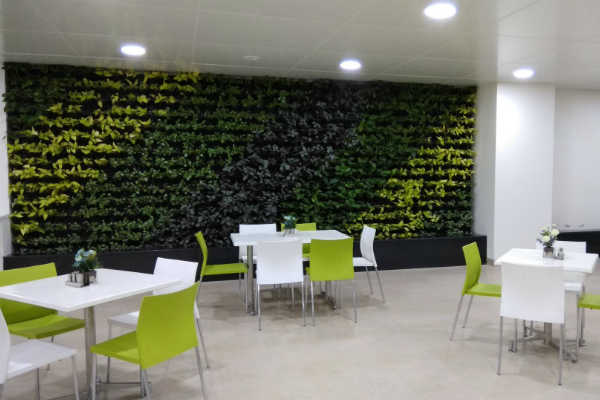This article revolves around the subject vertical gardening and how Columbia Asia Hospital in Sarjapur Road is using greenery and nature as an healing source
“Nature never did betray the heart that loved her!”
So said high priest of nature, William Wordsworth in his poem ‘Tintern Abbey’! Nature has since the beginning of time, not only created and sustained us, but also helped us recuperate and heal. And even till this date, when we live in the concrete jungles and are surrounded by state of art technology, we cannot help fall back to nature for healing us!
For most part of the twentieth century, the system and scheme of healthcare facilities were mostly concerned with the dominant curative medical model of treatment of maladies. The closing decades of the last century saw an increasing inclination towards a holistic approach to healthcare that recognises a deep but subtle relation between mind, body and life force which brought into the frame, the importance of healing gardens or restorative gardens in medical models. Experimental evidences suggest that patient rehabilitation necessitates the provision to include nature and open-air spaces in hospitals.
The endeavours by experts to incorporate nature into healthcare premises have been described multifariously as restorative gardens, healing gardens, contemplative gardens, enabling gardens and therapeutic gardens. Here, rather than emphasising on the atomistic notion of curing an individual of an ailment, the stress is upon a holistic curative methodology where the fringe benefits are associated with stress relief and the abilities of the nature to calm, to soothe and rejuvenate one’s mind and spirits as well. Restorative gardens or healing gardens first sprung up during the Middle Ages in Europe. Hospitals for the ailing and insane often included courtyards which served as places for cogitation and relaxation, growing flowers and fruits. A primary utility of the space is to provide a safe haven, to help in therapy and recuperation. According to healthcare architect Roger S. Ulrich, “a healing garden refers to a variety of garden features that have in common a consistent tendency to foster restoration from stress and have other positive influences on patients, visitors, and staff or caregivers.”
Columbia Asia Hospital, Sarjapur, Bengaluru has revolutionised this concept of healing gardens by introducing the idea of vertical gardening. Vertical gardening is a type of new age healing gardens that makes optimised use of spatially challenged urban landscape and architecture. Another advantage of the vertical gardens: they offer ease of accessibility, irrespective of whether one is walking, or on wheelchair or a stroller. Also, the plants are at reachable height where it is feasible for people touch and smell. Vertical gardens are not only splendid to look at, but also help one to feel relaxed and rejuvenated by striking the right chords to play the soothing tune nature.
Apart from the therapeutic benefits derived, the vertical gardens or green walls, as they are also known as, are found to be aiding in the reduction of the overall temperatures of the building in urban spaces. The flora, because of transpiration, keeps the buildings cooler. Vertical gardens are particularly suitable for urban spaces since they make great use of available wall areas. These could also serve as urban agriculture spaces while adding to the aesthetic and therapeutic values. Sometimes horizontal gardens are also built indoors to mitigate the ‘sick building syndrome’ since green walls are also recognised for improving the breathing atmosphere considerably even in closed spaces.
Vertical gardens, as healing gardens in hospitals provide a feeling of safety and peace, and thus help to soothe our spirits and relax. They infuse in people, a sense of tranquillity and hope, by communicating on various planes through sight, touch and smell. Today, vertical garden as therapeutic landscape design is intended by its architects to stimulate rhythms that vitalises the body, invigorates the mind and the spirit, and thus augment recuperation. The urban environment is overtly taxing, which gives rise to alleviated stress levels in the body. A touch of nature in these concrete jungles never fails to work wonders and invigorates humans with renewed life-force!
- Advertisement -



Comments are closed.